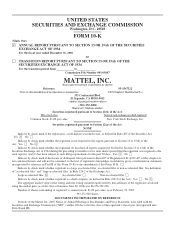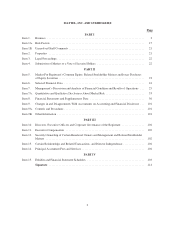Mattel 2006 Annual Report Download - page 18
Download and view the complete annual report
Please find page 18 of the 2006 Mattel annual report below. You can navigate through the pages in the report by either clicking on the pages listed below, or by using the keyword search tool below to find specific information within the annual report.Backlog
Mattel ships products in accordance with delivery schedules specified by its customers, which usually
request delivery within three months. In the toy industry, orders are subject to cancellation or change at any time
prior to shipment. In recent years, a trend toward just-in-time inventory practices in the toy industry has resulted
in fewer advance orders and therefore less backlog of orders. Mattel believes that the amount of backlog orders at
any given time may not accurately indicate future sales.
Financial Instruments
Currency exchange rate fluctuations may impact Mattel’s results of operations and cash flows. Mattel seeks
to mitigate its exposure to market risk by monitoring its foreign currency transaction exposure for the year and
partially hedging such exposure using foreign currency forward exchange and option contracts primarily to hedge
its purchase and sale of inventory, and other intercompany transactions denominated in foreign currencies. These
contracts generally have maturity dates of up to 18 months. In addition, Mattel manages its exposure to currency
exchange rate fluctuations through the selection of currencies used for international borrowings. Mattel does not
trade in financial instruments for speculative purposes.
For additional information regarding foreign currency contracts, see “International Segment” above,
Item 7A “Quantitative and Qualitative Disclosures About Market Risk” and Item 8 “Financial Statements and
Supplementary Data—Note 8 to the Consolidated Financial Statements.”
Seasonal Financing
Mattel maintains and periodically amends or replaces a $1.3 billion domestic unsecured committed
revolving credit facility with a commercial bank group that is used as the primary source of financing for the
seasonal working capital requirements of its domestic subsidiaries. The agreement in effect was amended and
restated in March 2005 and the expiration date of the facility was extended to March 23, 2010. The other terms
and conditions of the amended and restated facility are substantially similar to those contained in the previous
facility. Interest is charged at various rates selected by Mattel, ranging from market commercial paper rates to the
bank reference rate. The domestic unsecured committed revolving credit facility contains a variety of covenants,
including financial covenants that require Mattel to maintain certain consolidated debt-to-capital and interest
coverage ratios. Specifically, Mattel is required to meet these financial covenant ratios at the end of each fiscal
quarter and fiscal year, using the formulae specified in the credit agreement to calculate the ratios. Mattel was in
compliance with such covenants at the end of each fiscal quarter and fiscal year in 2006. As of December 31,
2006, Mattel’s consolidated debt-to-capital ratio, as calculated per the terms of the credit agreement, was 0.29
to 1 (compared to a maximum allowed of 0.50 to 1) and Mattel’s interest coverage ratio was 11.72 to 1
(compared to a minimum allowed of 3.50 to 1).
On December 9, 2005, Mattel, Mattel Asia Pacific Sourcing Limited (“MAPS”), a wholly-owned subsidiary
of Mattel, Bank of America, N.A., as a lender and administrative agent, and other financial institutions executed
a credit agreement (“the MAPS facility”) which provides for (i) a term loan facility of $225.0 million consisting
of a term loan advanced to MAPS in the original principal amount of $225.0 million, with $50.0 million of such
amount to be repaid on each of December 15, 2006 and December 15, 2007, and the remaining aggregate
principal amount of $125.0 million to be repaid on December 9, 2008, and (ii) a revolving loan facility consisting
of revolving loans advanced to MAPS in the maximum aggregate principal amount at any time outstanding of
$100.0 million, with a maturity date of December 9, 2008. Interest is charged at various rates selected by Mattel
based on Eurodollar rates or bank reference rates. On December 15, 2006, in addition to the required payment of
$50.0 million, MAPS prepaid an incremental $125.0 million of the MAPS term loan facility. The remaining
$50.0 million principal amount, consisting of $14.3 million due on December 15, 2007 and $35.7 million due on
December 9, 2008, was prepaid on January 16, 2007. As of December 31, 2006, there was no balance
outstanding on the MAPS revolving loan facility. In connection with the MAPS facility, Mattel executed a
9
























